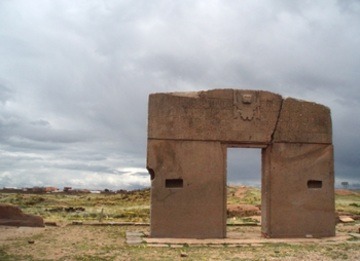Located near the southern shore of Lake Titicaca in Bolivia, the city of Tiwanaku (also spelled Tiah
Located near the southern shore of Lake Titicaca in Bolivia, the city of Tiwanaku (also spelled Tiahuanaco) was the capital of a powerful pre-Inca civilization that dominated the Andean region between 500 and 900 AD. The monumental remains of this great culture include several temples, a pyramid, symbolic gates, monoliths and mysterious carvings of alien-like faces. Arriving later, the Incas regarded Tiahuanaco as the site of creation by their god Viracoca, who rose from the depths of Lake Titicaca. As with many ancient megalithic sites around the world, the builders of Tiwanaku went to great lengths to construct their monumental temples. The basalt and sandstone slabs that lay around the site weigh as much as 25 tons each. And the nearest quarries that could have produced the basalt stones are on the Copacabana peninsula, 40km away. The sandstone blocks came from more than 5km away.Perhaps the most outstanding structure at Tiwanaku is the Akapana pyramid, built over an existing geological formation. Roughly square in shape, it covers 16 sq m at its base. In the center of the flat summit is a sunken oval area, generally attributed to the digging of early Spanish looters. Some archaeologists believe instead that it was used for water storage. A great deal of the pyramid’s stones were looted for use in local homes and churches, so overall the pyramid is no longer very impressive.North of the pyramid the Kalasasaya Temple, a ritual platform 130m by 120m in size. The walls are made of huge blocks of red sandstone and andesite. The blocks are precisely fitted to form a platform base 3m high. The massive entrance steps are flanked by two monolithic uprights. The restored portico leads to an interior courtyard and the ruins of priests’ quarters.Secondary platforms within Kalasasaya contain other monoliths, including El Fraile (the Priest). At the far northwest corner of the temple is the Puerta del Sol (Gateway of the Sun). Constructed of a single block of andesite, it is estimated to weight at least 44 tons. Archaeologists believe it was associated in some way with the sun god, and was perhaps used as a calendar.The surface is decorated with bas-relief designs and a sculpture of a deity on one side and a row of four deep niches, perhaps to hold offerings, on the other. Near the western end of Kalasasaya is a similar but smaller gateway carved with animal designs, which has been dubbed the Puerta de la Luna (Gateway of the Moon).East of the main entrance to Kalasasaya is the Templete Semisubterraneo, or the Semi-subterranean Temple. Some think this temple represents the Underworld, while Kalasasaya symbolizes the Earth. Made of red sandstone, the Subterranean Temple measures 26m by 28m in area and includes a rectangular sunken courtyard. Its walls are decorated with 175 intriguing sculptures of human faces. Some of the faces strongly resemble modern depictions of aliens, which naturally has led to some interesting speculations.West of Kalasasaya Temple is a large rectangular area known asPutuni or Palacio de los Sarcofagos, which is still being excavated. At the eastern end of the site is a heap of rubble known asKantatayita. Archaeologists have not yet been able to piece together what sort of structure was made from the pieces, but they are intriguingly carved with geometrical designs.Across the railroad tracks south of the main site is the archaeological site of Puma Punku (Gateway of the Puma). This temple complex contains megaliths weighing more than 440 tons. -- source link
Tumblr Blog : spoookyscary.tumblr.com
#titicaca#monolith#bolivia#tiwanaku#puma punku#temple#civilization#culture




